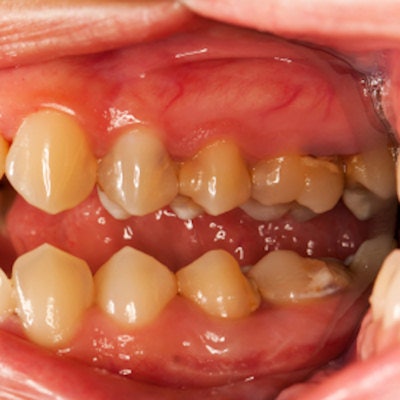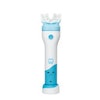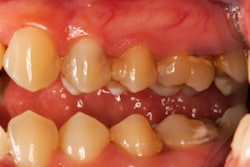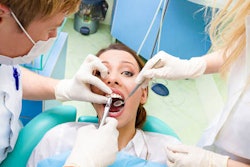
Research suggests links between periodontal disease and rheumatoid arthritis, so might scaling and root planing reduce signs of both diseases in patients with both conditions? To find out, investigators compared the effects of this treatment on periodontitis patients with and without rheumatoid arthritis.
They performed scaling and root planing in patients with moderate to severe chronic periodontitis, some of whom also had rheumatoid arthritis, and found that the rheumatoid arthritis patients experienced improvements in clinical and inflammatory parameters linked to each condition.
"In patients with rheumatoid arthritis and moderate to severe chronic periodontitis, nonsurgical periodontal therapy is a relevant modality not only to improve the periodontal condition but also to decrease rheumatoid arthritis activity," the authors wrote (Clinical Oral Investigations, March 27, 2018).
They were led by Raluca Cosgarea, DMD, an assistant professor and research fellow at the Clinic of Periodontology at Philipps University Marburg in Germany and an assistant professor at the Clinic of Prosthodontics at Iuliu Haţieganu University of Medicine and Pharmacy in Cluj-Napoca, Romania.
Reducing activity
Previous research suggests a possible relationship between periodontal disease and rheumatoid arthritis, both chronic inflammatory diseases in which inflammation occurs in an area composed of connective tissues, the authors noted.
Porphyromonas gingivalis has been suggested as a link between the two conditions because the bacterium is present in chronic periodontal disease, and the bacterial enzyme P. gingivalis-peptidylarginine deiminase is thought to play a role in the development of rheumatoid arthritis. Periodontal disease and rheumatoid arthritis also appear to have a similar cytokine profile featuring elevated levels of proinflammatory cytokines interleukin 1 beta, interleukin 6, and tumor necrosis factor alpha.
Some clinical trials have suggested that nonsurgical periodontal treatment can reduce the severity of rheumatoid arthritis, but evidence is limited. To learn more, the researchers of the current study examined the effects of nonsurgical periodontal treatment in 18 patients with moderate to severe chronic periodontitis and rheumatoid arthritis and 18 with chronic periodontitis who were systemically healthy.
The patients were all required to meet the following criteria:
- Age older than 30 years
- At least 10 natural teeth
- Full-mouth plaque score of 30% or less after oral hygiene instructions
- No other systemic diseases or medications known to influence periodontal conditions and treatment outcomes
- No infectious or heart diseases requiring prophylactic administration of antibiotics before dental treatment.
At baseline and three and six months after participants underwent treatment, the researchers collected data on medical and smoking history, clinical periodontal variables, periodontal pocket depth, clinical attachment level, bleeding on probing, gingival crevicular fluid, and subgingival plaque.
They also determined in the participants with rheumatoid arthritis the following markers of disease activity: Disease Activity Score 28 (DAS28), erythrocyte sedimentation rate, C-reactive protein, and rheumatoid factor. All rheumatoid arthritis patients were being treated with disease-modifying antirheumatic drugs, nonsteroidal anti-inflammatory drugs, and/or corticoids or anticytokine therapy.
The study participants each received oral hygiene instructions and professional prophylaxis sessions until they achieved a full-mouth plaque score of 30% or less. After that, they underwent scaling and root planing performed by one experienced periodontologist.
Under local anesthesia, all teeth with pocket depth of 4 mm or greater received treatment with sonic (SONICflex Scaler, KaVo) and hand instruments (Gracey curettes, Hu-Friedy). Treated pockets were rinsed with 0.2% chlorhexidine digluconate solution (Corsodyl, GlaxoSmithKline). Patients were told to rinse twice daily for two minutes with the same 0.2% chlorhexidine digluconate solution and brush teeth with 0.2% chlorhexidine digluconate toothpaste (Elugel, Pierre Fabre).
“Eradication of P. gingivalis combined with a good personal oral hygiene may be beneficial in decreasing disease activity of rheumatoid arthritis.”
At three and six months, they underwent removal of supragingival calculus, and researchers performed gingival crevicular fluid and microbial sampling in the deepest site in each quadrant in the patients with rheumatoid arthritis. Three of these participants did not take part in the six-month examination, and one did not attend the three-month visit.
At three and six months, clinical periodontal variables demonstrated statistically significant reductions from baseline in both patient groups. Additionally, serum C-reactive protein showed a statistically significant decrease at three months in the rheumatoid arthritis group. However, levels of inflammatory markers in the crevicular fluid were higher in the patients with rheumatoid arthritis than the other group at all time points.
Only the group without rheumatoid arthritis experienced statistically significant decreases in counts of P. gingivalis, Tannerella forsythia, and Treponema denticola. Changes in Disease Activity Score correlated positively with P. gingivalis and negatively with the plaque index.
"These data suggest that nonsurgical periodontal therapy is equally effective in patients with rheumatoid arthritis than in systemically healthy ones," the authors wrote.
They added that their results support the hypothesis that P. gingivalis plays a role in rheumatoid arthritis disease activity and emphasize the need for good oral hygiene in achieving low rheumatoid arthritis disease activity, although patients with severe rheumatoid arthritis may find it difficult to perform adequate oral hygiene.
Coming up short
The researchers acknowledged some shortcomings of their study. The patients with rheumatoid arthritis were statistically significantly older than the patients in the other group because younger rheumatoid arthritis patients who would have matched with the control group would not comply with the study appointments and were not included in the study.
Another discrepancy was that the researchers evaluated serum C-reactive protein in only the rheumatoid arthritis group. They chose not to measure this in the control group because blood would have needed to be taken for this purpose with no real patient benefit.
The authors also noted that certain gingival crevicular fluid proinflammatory markers did not change significantly over time in either group, which could be connected to the slight but statistically significant increase in full-mouth plaque scores at three months in both groups.
Nonetheless, scaling and root planing demonstrated benefits for periodontitis patients with rheumatoid arthritis, they concluded.
"Eradication of P. gingivalis combined with a good personal oral hygiene may be beneficial in decreasing disease activity of rheumatoid arthritis," the authors wrote.



















